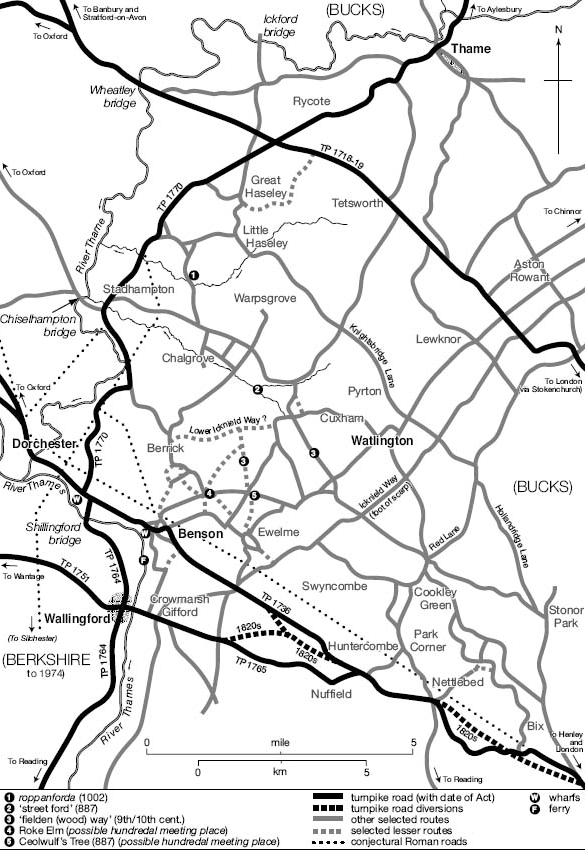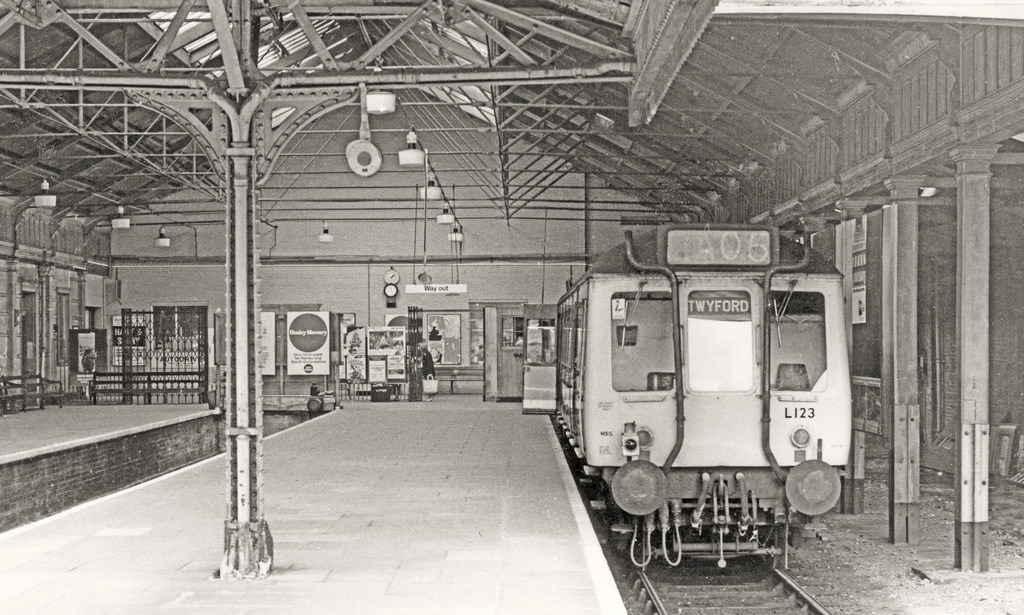
Roads: The most important of the Early Routes was the Road from Dorchester & Wallingford, almost certainly of Roman or earlier Origin, which enters modern Henley along the Fair Mile. Westwards, it connected with the North-South Road from Watling Street & Alchester, which ran through Dorchester and on to Silchester. East of the River Thames it probably joined the main Roman Road to St Albans (Verulamium), although where it Crossed the Thames has not been definitively Established. Presumably, the Road continued in use during the Anglo-Saxon Period, linking the Royal Centre at Benson & the Alfredian burh at Wallingford with the important Royal Minster at Cookham in Berkshire. Possibly it helped to determine the shape & extent of the Bensington Estate (Royal Manor), which extended along much of its length, straddling both the Chilterns & the later Hundred Boundaries.
The Building of a Bridge at Henley in or before the late 12thC both reflected & enhanced the Dorchester Road’s importance, particularly from the early or mid-13thC as Henley emerged as a major Trans-Shipment point. By then it formed part of the Main Route from London to Gloucester & the Welsh Marches, which passed through Wallingford & Oxford until the Building of Abingdon Bridge in the early 15thC. Thereafter the favoured Route for long-distance Westwards Traffic from Henley was through Abingdon, Faringdon, & Lechlade, or through Witney & Burford via Newbridge. The Dorchester Road nonetheless remained the Chief Route from Henley to Oxford.

Of the other early Routes, one of the most significant was through the Assendon Valley to Watlington. In the Anglo-Saxon Period, this connected with a Route along Knightsbridge Lane through Pyrton and eventually to Oxford. Probably it retained considerable importance in the Middle-Ages, when it may have connected the Thames Valley with Worcester. The Road through Bix Bottom seems to have provided an alternative Northerly Route in the earlier-Middle-Ages, although it declined thereafter.
The Statute of Westminster of 1285 set the Obligation to Maintain the Highway upon each Manor, and hence upon each Constable as a Manorial Officer. Afterwards Petitions about Roads began to be submitted to the Crown in one of the 2-Houses of Parliament: hence “The King’s Highway”. The Parliament Rolls Record of 1290 had Walter Goodlake of Wallingford seeking permission to Levy Tolls on a stretch of Road to carry out Repairs. In 1304, a Road leading to Salisbury was placed in the charge of the Bishop to ensure its Repair. The petitions sometimes resulted in a Private Act; the earliest is a Statute of 1421, dedicating a recently-repaired Road & Bridges between Abingdon & Dorchester-on-Thames to Public use. Parliamentary Legislation governed many aspects of Public Roads, including restricting the size of Loads carried on them or specifying minimum Wheel Widths.
By the 13th or 14thC and probably much earlier, a Network of Roads linked Henley with the surrounding Towns of Watlington, Wycombe, Marlow, Maidenhead, & Reading. The Reading–Marlow Road, intersecting the Dorchester–London Road at Henley’s Northern end, must have been a Major route by the time the planned Town was laid out, and almost certainly existed in the late Anglo-Saxon Period. Traffic from Southampton, recorded in the 15thC, perhaps also entered Henley through Reading. A Road from Hambleden, presumably part of the Marlow Road, was mentioned in 1416, and a Road from Goring (passing to Henley probably through Rotherfield Greys) in 1353.
The condition of English roads deteriorated with the decline of Travelling in the 14th, 15th & 16thCs. The Highways Act, 1555, transferred Highway Duties from the Manor to the Parish. It required each Parish to meet Annually & Elect, at a Vestry Meeting organised by the Constable & Churchwardens, 2-unpaid Surveyors of Highways with the Duty of Inspecting Highways & Bridges & Supervising the “Statute” Labour. Under this Statute for 4-consecutive days every year, every Parishioner occupying Tilled or Pasture Land worth £50 or more per annum, and owning a Plough or keeping Horses had to provide “1-Wain or Cart furnished after the Custom of the Country – and also 2-able men with the ‘same’ for the Cartage of Road Materials. Other Parishioners able to work (excluding Servants Hired by the year) had to give their Labour or to send “1-sufficient Labourer in his stead”. This remained the Highway Law for almost 3-Centuries until the Highways Act of 1835 (which also formalised the Practice of Driving on the Left).
Travellers throughout England complained to Parliament about Roads being too Narrow for Vehicles to pass and full of deep, muddy pot-holes because of inadequate maintenance by the adjoining Parishes. In 1760 the Writer Arthur Young who made a Series of Journeys through England & Wales wrote that the Oxfordshire Roads are “in a condition formidable to the Bones of all who Travelled on Wheels”. The explanation, well-known at the time, was that “When Roads are worn by the Public at Large Tenfold, or more in some instances, than by the Inhabitants of the Parishes they happen to pass through, it becomes unreasonable, if not unjust, to impose the Task of Repairing them on the Individuals who happen to be possessed of a Plough Team, a Cart, a Wheelbarrow, a Shovel, or a Basket (what a Principle of Taxation these days!), though they may never use the Road they are Doomed to Repair”
From the early 18thC the Chief Roads through Henley were improved by Local Turnpike Trusts and on Private Initiative. Work was inspired by a general increase in Traffic, and particularly by the growth of Coaching. The Road from Maidenhead to Henley Bridge was Turnpiked in 1718, and the Henley – Dorchester Road (continuing to Oxford via Abingdon) in 1736. The South-North Route from Reading to Marlow, continuing to St Albans & Hatfield (Herts), was Turnpiked in 1768. In the 1780s, by which time Coaching had ‘greatly increased‘ Traffic over Henley Bridge, the Dorchester Road formed part of the Great Western Road from London, leading to South Wales and the North-West of England. The Bridge itself was re-Built in 1781-86.

The increased Manufacturing & enlarged Urban Population created extra Trading activity in moving Coal from Mines to Factories, Wool & Cotton to Mills, together with Grain, Foodstuffs, Cloth & other Manufactured Goods to the Markets of working & commercial Urban Populations in the Market Towns that had been Granted the Right to hold a Market by the Monarch from 1199. They brought change and led to booms in the Construction of Canals, of Turnpike Roads &, later, of Railways.

Coaching declined rapidly with the provision of Local Railway Links in 1839–40, though some goods continued to be Transported between Henley & London by Road, especially before the belated Opening of a Railway Station at Henley itself. Additional Local Road Traffic was created by Carriers operating between the New Railway Stations and nearby Settlements. The scale of Road use was transformed in the 2nd half of the 20thC, partly through the general spread of Private Motor Car Ownership, but also through improved long-distance Communications following the Construction of the M4 & M40 Motorways in the 1960s & 1970s. Congestion around Henley and its narrow 18thC Bridge remained a problem in the early 21stC.
River & Rail: The Thames provided a major Trade & Transport Route from early times, especially in Periods of Economic growth. The Scale & Frequency of activity in late-Prehistory & the Roman Period remains uncertain, but Goods seem to have been moved along it (especially Downstream) from at least the later Bronze Age, and by the late-Iron Age Thames Trade may have been highly important. Usage seems to have intensified in the 10th & 11thCs, thanks partly to Canalisation.
From then until the 19thC the River remained a major Artery for Commerce, though not always to the same degree along its whole length. An increase in the number of Weirs & Mill-Dams between the 10th & 14thCs seems to have made Navigation Upstream from Henley increasingly difficult, and from the 14thC falling demand from Oxford and from Upriver Towns such as Wallingford (both of which experienced economic difficulties in the later Middle-Ages) probably further reduced Merchants’ profit margins on the Upper Stretches. Occasional Navigation to Oxford continued until at least the mid-15thC, but by the mid-13thC Henley was being used for Trans-Shipment of Goods and by c.1300 it was a significant ‘Breakpoint‘, beyond which regular, large-scale Commercial Navigation seems to have been regarded as Uneconomical. Consequent neglect of the higher Thames probably cemented Henley’s role as the pre-eminent Trans-Shipment point for Goods being Transported to & from London. That Role was undermined by the reopening of regular Navigation to Oxford and beyond in the early 17thC, following major Engineering Works by the Oxford-Burcot Commission. The Commission took responsibility for the Management of the River Thames between Oxford & Burcot. Burcot, nr Clifton Hampden, in the 17thC was an important Trans-shipment Point on the Thames. Nonetheless, increased demand from London ensured that Henley continued as a major Inland Port, supporting a significant Body of Bargemen & other River Workers, and Trading in the increased variety of Goods which were carried on the Thames by the later 18thC.
The Construction in 1839–41 of the Great Western Railway from London to Bristol crippled Henley’s Coaching Trade almost immediately & initiated a protracted Decline in Commercial use of the River. Henley’s initial failure to secure a Branch Line from Twyford caused severe Economic problems for the Town, which became a Transport Backwater until a Station was opened in 1857, with another small Stop at Shiplake 1½-miles to the South. Although Services were Limited, especially before the 1890s, the Railway proved highly important for both Passenger & Goods Transport, providing a Catalyst for Henley’s regeneration as a Riverside Resort and for the Gentrification of the area more generally. Regular through-Services to London were Abandoned in the 1970s, but Direct Peak-time Services to Paddington were reinstated in 1993 and remained well-used in 2009. A Reading Service introduced in 1988 was later dropped.
